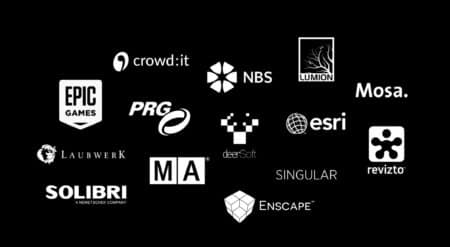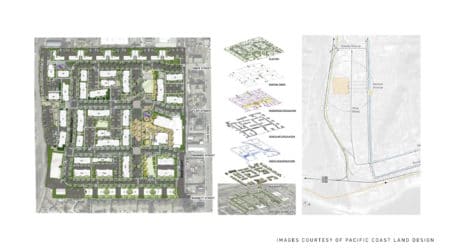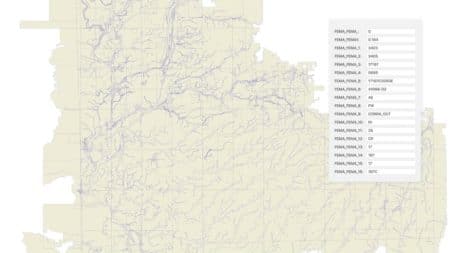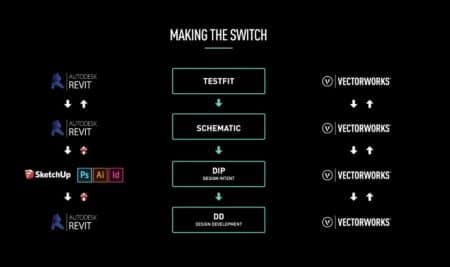Continued from page 1
Integrations and Further BIM-ness
Big BIM doesn’t stop with those technologies just mentioned. The company’s new Vectorworks Graphics Sync (VGS) further expands integrations. One such integration is with Solibri, a sister Nemetschek company. “We are working on adding the Solibri API to Vectorworks so you can check a model at any time,” says Dr. Sarkar. He also mentioned further Solibri-Vectorworks’ possible futures off the record. The bottom line is that the critical BIM tool Solibri will continue to have more advanced integrations in the future of Vectorworks.

Vectorworks’ integrations now and near future. (Image: Vectorworks / Architosh. All rights reserved.)
Solibri is just one of the key integrations helpful to architects in a BIM process. Recently released, a new integration with Revizto, a real-time BIM model visualization tool useful to collaboration. Another is with UK-based NBS Chorus, a tool that enables architects to attach specification data to objects in a BIM model. Dr. Sarkar says that with the new Live Sync API technology, a palette can become a web browser, and in this case, link real-time data from NBS Chorus with objects in the BIM model.
Finally, an additional integration includes upcoming live sync with rendering tools Twinmotion to complement what has already been done with the very popular Lumion and Enscape.
Leadership in Verticals
One area where Vectorworks has established a critical beachhead in a vertical is in landscape design firms who are, for a variety of reasons, committing to BIM. I asked Dr. Sarkar to elaborate. “We do not have a lot of competition with respect to the positioning that we are trying to do, which is BIM for landscape architecture.”
An interesting aspect of landscape design professionals is that their workflows do require a fair amount of 2D needs— intensive scheduling, extensive detailing, and even hand drawing. But Vectorworks Landmark’s BIM capabilities have increasingly meant that landscape architects participating in BIM-based projects can fully participate in the BIM process alongside their design peers in other disciplines. Dr. Sarkar notes that in this respect, they have no real competitors. Landscape architects are not, in general, using pure BIM platforms like Revit or ArchiCAD; they largely use AutoCAD and often with specialized add-ons. “Mainly we are competing with Land F/X,” adds Sarkar, mentioning a California software company focused on plugin add-ons for AutoCAD, plus an OEM version of AutoCAD just for landscape architects.

Vectorworks Landmark is the market BIM leader for landscape professionals. (Image: Pacific Coast Land Design / Architosh. All rights reserved.)
From this angle, Vectorworks Landmark sits in a special spot. It can not only match and out-compete rival 2D CAD products on visuals and graphics, but it also offers a mature and modern BIM platform that allows landscape designers a seamless segue from exclusive 2D workflows to hybrid 2D/3D/BIM workflows.
While landscape design and entertainment design are wholly unique AEC verticals—requiring specialized toolsets and utilized by differing credentialed and trained professionals—interior design work cuts across multiple domains of projects and professionals. While the first two fields are crisp and clear domains, they also have separate Vectorworks industry software packages. What came across from the virtual keynote is that Vectorworks may be thinking along similar lines but for those involved in various aspects of interior design and interior architecture, two fields that overlap not just each other but architecture itself.

Esri integration with Vectorworks is rather new but advancing quickly and of increasing value to both architects and landscape design professionals alike. (Image: Vectorworks / Architosh. All rights reserved.)
I asked Dr. Sarkar if I was imagining it, or was I picking up on a trend line that the interiors professional was another growing vertical market for them to focus on?
“That is exactly correct,” was his answer. “Interiors [or the needs for them] are something we see everywhere,” said Dr. Sarkar. “When I go to Japan, I see 500 seat companies that are just doing interiors. For example, Nomura Corporation or Space Corporation; these are huge companies that are doing office interiors or restaurant interiors, and things of that nature.”
Sarkar says that these types of users are indeed unique and do have different but similar workflows to the typical architect. For example, he tells me a story about an interiors customer who asks if he has something to help him calculate light intensity levels or lux values. He then mentions that these types of customers also need different rendering needs. Their work is no doubt a bit more “materials” based, and they may have a much higher demand to fully simulate and portray a final space as it actually will be. Where architects can create atmospherics around their building designs—something they have been doing since the days of Beaux-Arts watercolor renderings—interior and retail designers need to create “digital prototypes.” And, increasingly, they need to occupy them virtually.
We do not have a lot of competition with respect to the positioning that we are trying to do, which is BIM for landscape architecture.
One might think of all the physical prototypes Steve Jobs required for the early days of the Apple Stores. They still do many. For companies with resources far less than the largest tech company in the world, virtual digital prototypes can be nearly as good when virtual reality is combined with high-fidelity real-time rendering. This is where Lumion, Twinmotion, and Enscape begin to play a pivotal role.
It is not yet clear if we will see a Vectorworks Interiors package yet, unique from Vectorworks Architect, but one can imagine such a thing making sense in the near future. Especially so when you consider that the company shared the news that a global coffee business giant has completely adopted Vectorworks for its entire design-development-documentation workflow, in Europe with its 60-person strong corporate retail design team.

A very large multi-international client and their 60-person corporate design department have analyzed their use of Vectorworks and other solutions over project phases—chart above. They have decided to move to a nearly 100 percent Vectorworks workflow. (Image: Vectorworks Inc. / Architosh. All rights reserved.)
To convince the corporate board to move entirely away from a workflow consisting of SketchUp, Revit, and Adobe Suite products, and do everything instead with just Vectorworks, they presented their older workflow with software packages shown. (see image above). Then they demonstrated how the retail design team could handle the entire process in one software package: Vectorworks. This is not only saving on software application costs, but it also is simplifying workflows.
And speaking of workflows again, think about the post-pandemic environment. In general, with any software, working remotely is something that must be figured out. It may be simple, it may be a bit more complex, but in any case, the fewer apps you have to configure for remote work, the better. This is an argument, however, that counters the virtues of an ecosystem of “Open BIM” applications, all talking to each other. We are in the early stages of this post-pandemic environment. Nobody needs to have all the answers today; time will tell us what works best in the new remote work context.
Closing Thoughts
Vectorworks is treating its BIM/CAD platform like an “OS” for design while building out features for ever-sharper market advantages in specific industry verticals. Those verticals are only the arms on a “starfish-like” competitive strategy.
As anybody can see from looking at an actual starfish, their bodies work from a circular disc outward. The five arms of a typical starfish grow out in different directions; and, it’s the arms that make it all move. If we think of the starfish analogy we might ask, are the “arms” the Vectorworks verticals? And if so, is architecture just another arm in this analogy, or is it located in the center disc of the starfish? This is a very interesting question given the history of Vectorworks.

Switzerland’s largest architecture firm has been a Vectorworks user for decades, implementing Big BIM workflows. (Image: Scott Headquarters in Europe, by Itten+Brechbühl / Architosh. All rights reserved.)
Perhaps the better question in this analogy is not to ask where architecture sits in this body but rather where BIM technologies sit. This seems a bit clearer. In this case—particularly with the Landmark strategy—BIM seems to sit at the very center of the starfish-like competitive strategy for Vectorworks. As time goes on, it seems BIM technologies will penetrate deeper into the verticals like landscape but also interiors and even entertainment design. Each of these industries will modulate 2D/BIM workflow integration differently, respective of the disciplines, giving users a wide bandwidth of tools options to configure their practices around.
Image Credits
Format equates to “party with copyright” / “party with reserved rights of use.” (eg: image: Itten+Brechbühl / Architosh. All rights reserved.) Not credited images are copyrighted to Architosh.
Title Credit: ( Image: 3+1 Architects, Estonia/ Architosh. All rights reserved.)




Reader Comments
Comments for this story are closed